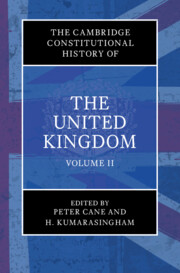Book contents
- The Cambridge Constitutional History of the United Kingdom
- The Cambridge Constitutional History of the United Kingdom
- Copyright page
- Contents
- Contributors
- Editors’ Preface
- 1 The Kingdoms of Anglo-Saxon England (450–1066)
- 2 England after the Conquest
- 3 England in the Thirteenth Century
- 4 England in the Fourteenth Century
- 5 England in the Fifteenth Century
- 6 England in the Sixteenth Century
- 7 The English Constitution in the Seventeenth Century
- 8 A European Perspective
- 9 Wales before Annexation
- 10 The Scottish Constitution before 1707
- 11 The Eighteenth-Century Constitution
- 12 The Constitutional and Parliamentary History of Ireland till the Union
- 13 The United Kingdom in the Nineteenth Century
- 14 The United Kingdom in the Twentieth Century
- 15 The Twenty-First-Century Constitution
- 16 Wales since the Annexation
- 17 Scotland in the Union
- 18 Ireland in the Union
- 19 The Making of Empire
- 20 Constitution and Empire
- Index
4 - England in the Fourteenth Century
Published online by Cambridge University Press: 12 August 2023
- The Cambridge Constitutional History of the United Kingdom
- The Cambridge Constitutional History of the United Kingdom
- Copyright page
- Contents
- Contributors
- Editors’ Preface
- 1 The Kingdoms of Anglo-Saxon England (450–1066)
- 2 England after the Conquest
- 3 England in the Thirteenth Century
- 4 England in the Fourteenth Century
- 5 England in the Fifteenth Century
- 6 England in the Sixteenth Century
- 7 The English Constitution in the Seventeenth Century
- 8 A European Perspective
- 9 Wales before Annexation
- 10 The Scottish Constitution before 1707
- 11 The Eighteenth-Century Constitution
- 12 The Constitutional and Parliamentary History of Ireland till the Union
- 13 The United Kingdom in the Nineteenth Century
- 14 The United Kingdom in the Twentieth Century
- 15 The Twenty-First-Century Constitution
- 16 Wales since the Annexation
- 17 Scotland in the Union
- 18 Ireland in the Union
- 19 The Making of Empire
- 20 Constitution and Empire
- Index
Summary
The constitution of any state, whether written or unwritten, is the set of political, governmental and legal structures and shared values within which the business of everyday politics and governance operate. In fourteenth-century England there occurred the first two depositions in post-Conquest English history, which were precipitated by ‘unconstitutional’ behaviour by the monarchs in question and were effected by ‘unconstitutional’ legal devices on the part of the community of the realm. It was a century of cataclysmic demographic transformation brought about by the Black Death, of almost constant warfare with Scotland and France and of spectacular governmental growth and legal change. It is therefore ironic that, when English constitutional history was at its height, in the late nineteenth and early twentieth centuries, the fourteenth century, parliamentary developments apart, was regarded as a sorry backwater. It was useful only to reflect on how a wrong turning had been taken. ‘We pass’, Bishop Stubbs lamented, ‘from an age of heroism to the age of chivalry, from a century ennobled by devotion and self-sacrifice to one in which the gloss of superficial refinement fails to hide the reality of heartless selfishness and moral degradation’.1
- Type
- Chapter
- Information
- The Cambridge Constitutional History of the United Kingdom , pp. 84 - 107Publisher: Cambridge University PressPrint publication year: 2023

